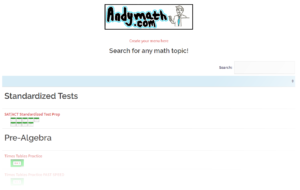To find the area or perimeter of a shape formed with (x,y) points, first plot the points, then use whatever method you can to find the length of the sides.
\(\bullet\) For the perimeter, add up the sides.
\(\bullet\) For the area, use the appropriate area formula for the shape you have.
Practice Questions
\(\textbf{1)}\) A rectangle is formed with the points \( (3{,}4),(6{,}4),(6{,}9),\) and \( (3{,}9).\) What is the area and perimeter of the rectangle?
\(\textbf{2)}\) A triangle is formed with the points \( (1{,}5),(1{,}8),\) and \( (5{,}5).\) What is the area and perimeter of the triangle?
\(\textbf{3)}\) What is the area of a triangle with vertices at \((2{,}3), (2{,}8) \) and \((8{,}7) \) ft?
\(\textbf{4)}\) What is the area of a triangle with vertices at \((5{,}9), (9{,}9) \) and \((4{,}4) \) ft?
See Related Pages\(\)
\(\bullet\text{ Geometry Homepage}\)
\(\,\,\,\,\,\,\,\,\text{All the Best Topics…}\)
\(\bullet\text{ Coordinate Plane Rectangle Calculator (Mathopenref.com)}\)
\(\)
\(\bullet\text{ Andymath Homepage}\)
In Summary
The perimeter of a figure in the coordinate plane is the total length of its sides. The area of a figure is the amount of space it occupies. Perimeter and area are important concepts in geometry that are used to measure the size and shape of two-dimensional figures. In the coordinate plane, we can use these concepts to find the perimeter and area of figures whose sides are defined by points with coordinates.
Perimeter and area in the coordinate plane are typically covered in a high school geometry class.
Real world examples of Perimeter and Area
Designing a garden: When designing a garden, you may use the perimeter and area concepts in the coordinate plane to determine the size and shape of the garden bed and to calculate the amount of soil or other materials you will need.
Measuring a room: You can use the perimeter and area concepts in the coordinate plane to measure the size of a room by finding the length of the walls and the floor space within them.
Planning a construction project: In a construction project, you may use the perimeter and area concepts in the coordinate plane to determine the size and shape of the building or other structure, as well as to calculate the amount of materials needed.
Analyzing data on a map: You can use the perimeter and area concepts in the coordinate plane to analyze data on a map, such as the size and shape of a city or the distribution of a particular feature within a region.
Calculating the size of a field or plot of land: You may use the perimeter and area concepts in the coordinate plane to measure the size of a field or plot of land, which can be useful for agricultural or other purposes.
Topics related to Perimeter and Area in the Coordinate Plane
Triangles: The perimeter and area of a triangle can be calculated using the coordinates of its vertices in the coordinate plane.
Quadrilaterals: The perimeter and area of a quadrilateral, such as a rectangle or parallelogram, can be calculated using the coordinates of its vertices in the coordinate plane.
Circles: The perimeter and area of a circle can be calculated using the coordinates of its center and its radius in the coordinate plane.
Polygons: The perimeter and area of a polygon can be calculated using the coordinates of its vertices in the coordinate plane.
Transformations: The perimeter and area of a figure can be affected by geometric transformations, such as translations, rotations, and reflections. Understanding these concepts can help you to visualize how the size and shape of a figure can change in the coordinate plane.
Andymath.com is a free math website with the mission of helping students, teachers and tutors find helpful notes, useful sample problems with answers including step by step solutions, and other related materials to supplement classroom learning. If you have any requests for additional content, please contact Andy at tutoring@andymath.com. He will promptly add the content.
Topics cover Elementary Math, Middle School, Algebra, Geometry, Algebra 2/Pre-calculus/Trig, Calculus and Probability/Statistics. In the future, I hope to add Physics and Linear Algebra content.
Visit me on Youtube, Tiktok, Instagram and Facebook. Andymath content has a unique approach to presenting mathematics. The clear explanations, strong visuals mixed with dry humor regularly get millions of views. We are open to collaborations of all types, please contact Andy at tutoring@andymath.com for all enquiries. To offer financial support, visit my Patreon page. Let’s help students understand the math way of thinking!
Thank you for visiting. How exciting!
